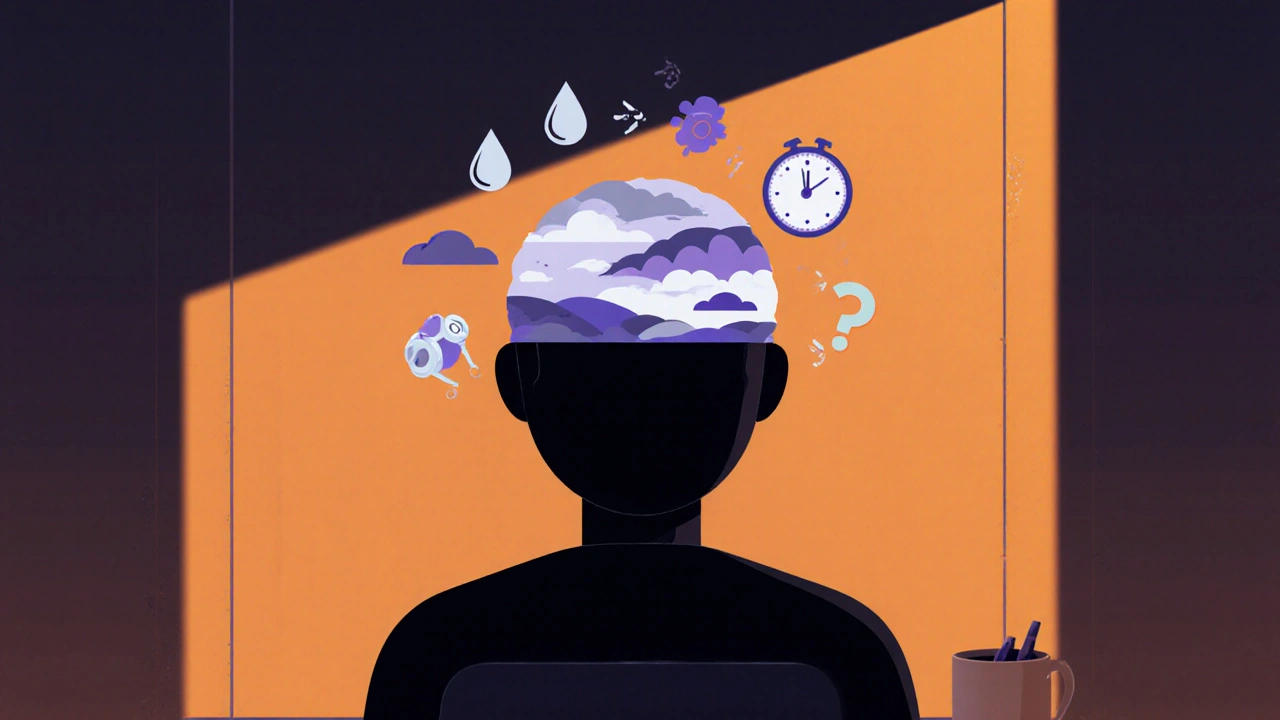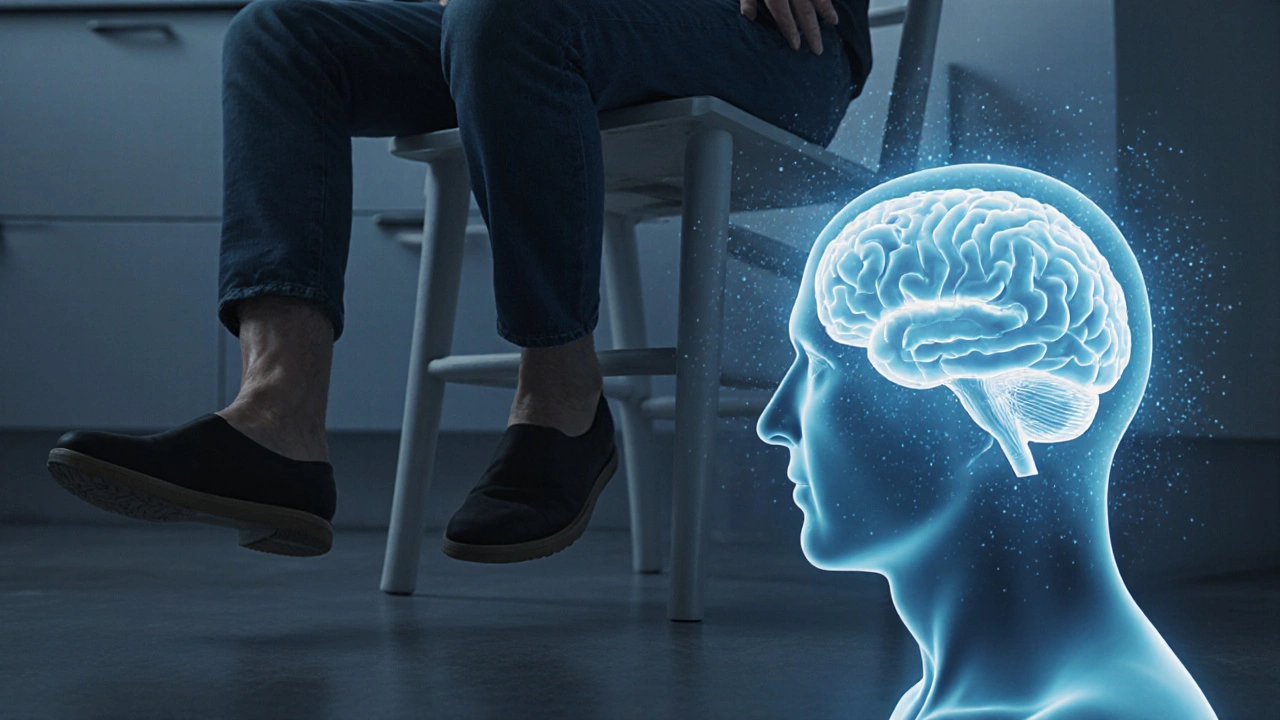Mental Health Impact Risk Calculator
This tool assesses your risk of depression or anxiety related to orthostatic hypotension symptoms. Based on a 2024 longitudinal study showing a 1.8x increased risk of clinical depression in IOH patients, this calculator helps identify potential warning signs early.
Symptom Assessment
Rate your symptoms on a scale of 1-5 (1=Never, 5=Always)
Your Risk Assessment
When you stand up, your body’s Idiopathic Orthostatic Hypotension is a condition where blood pressure suddenly drops without an obvious cause, leading to dizziness, fainting, and a cascade of hidden effects on the brain.
What is Idiopathic Orthostatic Hypotension?
Idiopathic orthostatic hypotension (IOH) is a subtype of orthostatic hypotension where doctors cannot pinpoint a drug, disease, or neurological injury as the trigger. It typically shows up in adults over 40, affecting roughly 2‑5% of the general population according to a 2023 epidemiology review. The hallmark is a ≥20mmHg systolic or ≥10mmHg diastolic fall within three minutes of standing.
The sudden dip starves the brain of oxygen, triggering the autonomic nervous system to scramble for compensatory mechanisms. If those mechanisms fail, you feel light‑headed, see visual “gray outs,” or even lose consciousness.
How Blood‑Pressure Drops Reach the Brain
The brain relies on cerebral blood flow to stay sharp. A rapid fall in systemic pressure reduces the perfusion gradient, especially in the frontal lobes that handle mood, attention, and executive function. Studies using transcranial Doppler ultrasonography in 2022 showed a 15‑20% reduction in middle cerebral artery velocity during an orthostatic challenge in IOH patients.
That temporary hypoperfusion can trigger a cascade of neurochemical changes: less dopamine, altered serotonin turnover, and a rise in cortisol. Those shifts are precisely what we see in mood disorders.

Link Between Blood‑Pressure Drops and Mood Disorders
Research consistently connects orthostatic drops with higher rates of depression and anxiety. A 2024 longitudinal study of 1,200 seniors found that those with unexplained orthostatic hypotension were 1.8 times more likely to develop clinical depression over a two‑year span.
The mechanism is two‑fold. First, the brain’s “reward circuitry” receives less oxygen, dulling pleasure responses. Second, the constant fear of fainting creates anticipatory anxiety-people start avoiding social outings, exercise, or even simple chores, which feeds a depressive loop.
Risk Factors and Warning Signs
- Rapid heart‑rate increase on standing (tachycardia) indicating compensatory effort.
- Frequent “near‑falls” or episodes of blurred vision after standing.
- Persistent fatigue that does not improve with rest.
- New‑onset mood swings, irritability, or loss of interest in hobbies.
- Co‑existing conditions such as diabetes, Parkinson’s disease, or chronic dehydration, which can worsen autonomic dysfunction.
Spotting these signs early is crucial because mental‑health impacts often surface before the physical episodes become severe.
Managing Physical Symptoms to Protect Mental Health
When the body’s blood‑pressure control improves, the brain gets steadier oxygen, and mood symptoms often recede. Here are evidence‑backed interventions:
- Medication: Low‑dose midodrine raises vascular tone by stimulating alpha‑1 receptors. A 2023 trial reported a 30% reduction in fainting episodes and a modest 5‑point drop in PHQ‑9 depression scores.
- Fludrocortisone increases sodium retention, expanding blood volume. Careful monitoring is required to avoid hypertension at night.
- Compression stockings (grade 30‑40 mmHg) minimize blood pooling in the legs. Patients who wore them daily reported better energy levels and less anxiety about standing.
Lifestyle Strategies and Therapeutic Options
Non‑pharmacologic measures act as the first line of defense and can directly lift mood.
- Hydration: Aim for 2-3L of fluid daily, adding a pinch of salt if tolerated.
- Physical counter‑maneuvers: Leg crossing, calf‑muscle tensing, or rapid squats for 30 seconds before sitting can raise systolic pressure by 10-15mmHg.
- Gradual position changes: Rise slowly from supine to sitting, pause, then stand.
- Exercise: Light resistance training improves vascular tone and releases endorphins, cutting both depressive and anxious symptoms.
- Cognitive‑behavioral therapy (CBT): Target fear of fainting, restructure catastrophic thoughts, and introduce coping skills.
- Mind‑body practices: Yoga or tai chi enhance autonomic balance and have shown a 12% reduction in orthostatic fall severity in a 2022 pilot.
Combining at least two of these strategies often yields the best results. For example, a patient who added compression stockings, practiced daily calf raises, and attended weekly CBT reported a 70% drop in both dizziness episodes and PHQ‑9 scores within three months.
When to Seek Professional Help
If you notice any of the following, book an appointment promptly:
- Unexplained loss of consciousness.
- Persistent low mood or anxiety that interferes with work or relationships.
- Chest pain, shortness of breath, or palpitations alongside standing‑related symptoms.
- Medication side‑effects such as severe hypertension or fluid overload.
Specialists-cardiologists, neurologists, and mental‑health clinicians-can run tilt‑table tests, autonomic function panels, and psychiatric assessments to craft an integrated treatment plan.
Frequently Asked Questions
Can idiopathic orthostatic hypotension cause memory problems?
Yes. Repeated drops in cerebral perfusion can impair the hippocampus, leading to short‑term memory lapses and difficulty concentrating. A 2021 neuroimaging study linked frequent orthostatic episodes with reduced gray‑matter volume in the temporal lobes.
Is it safe to use midodrine if I already have high blood pressure?
Midodrine is usually prescribed at low doses and monitored closely. If you have baseline hypertension, your doctor may choose an alternative like fludrocortisone or focus on non‑drug measures first.
Do compression stockings help with anxiety?
Indirectly, yes. By reducing dizziness and the fear of fainting, they lower situational anxiety. Many patients report feeling more confident walking into meetings or social events when they know the stockings are preventing blood pooling.
How long does it take to see mental‑health improvement after treatment?
Improvement varies. Physical symptom control often shows benefits within weeks, while mood changes may take 6-12 weeks, especially if psychotherapy is added. Consistency is key-regular hydration, wearing stockings, and attending CBT sessions accelerate recovery.
Can lifestyle changes replace medication entirely?
For some mild cases, yes. A structured program of fluid intake, gradual position changes, and regular exercise can maintain blood pressure within normal limits. However, moderate‑to‑severe IOH often benefits from a combined approach-medication to stabilize pressure and lifestyle tweaks to sustain it.


Written by Felix Greendale
View all posts by: Felix Greendale